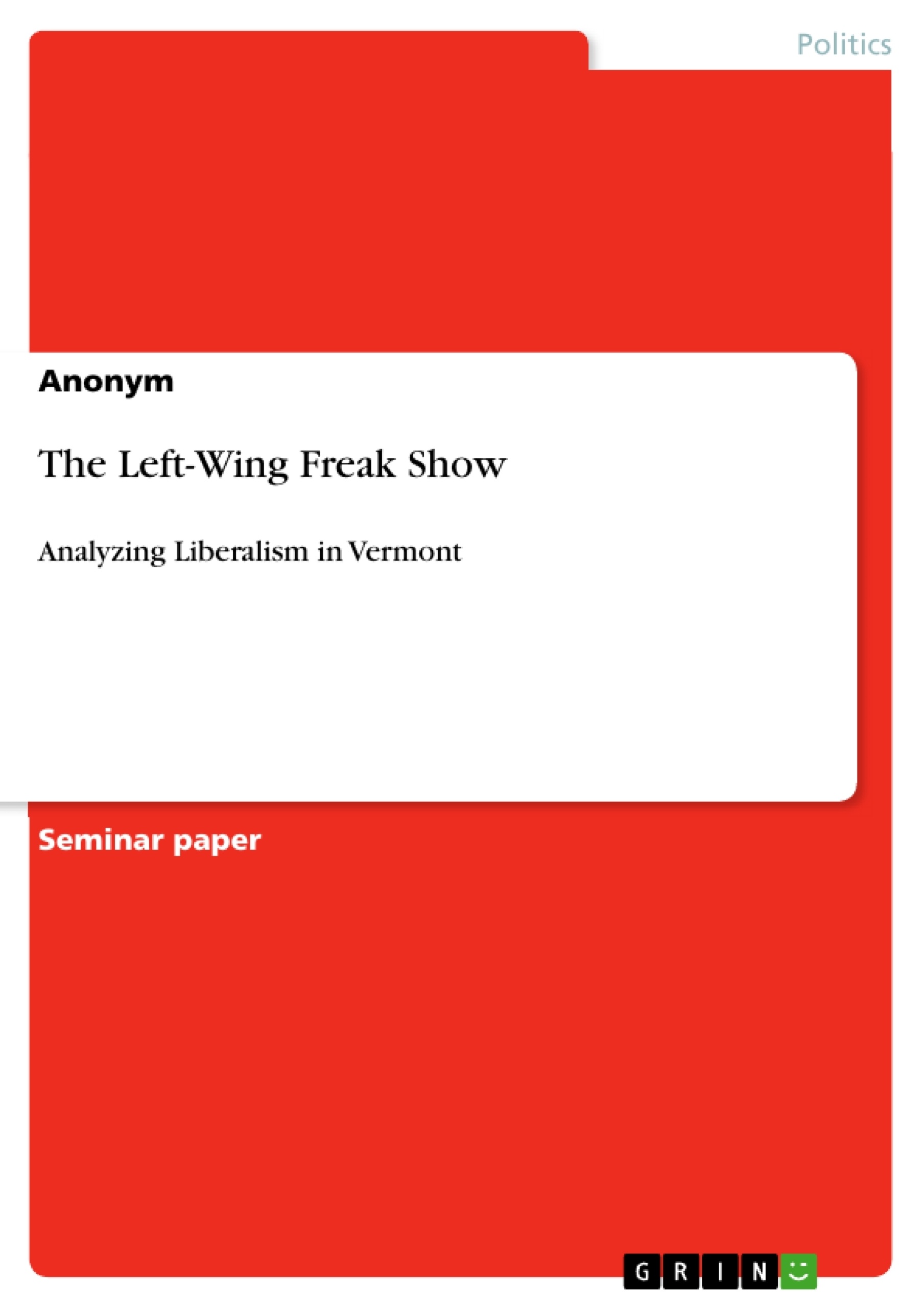In a campaign ad aired in early 2004 by the conservative Club for Growth, Democratic
presidential candidate Howard Dean, the former governor of Vermont, was scolded by two
supposedly average American people who advised him to “[…] take his tax-hiking,
government-expanding, latte-drinking, sushi-eating, Volvo-driving, New York Timesreading,
body-piercing, Hollywood-loving, left-wing freak show back to Vermont, where it
belongs.”1 The quote became quite famous for it apparently hit the nail on the head with its
characterization of the divide between conservative and liberal America, the latter being
perfectly epitomized by the state of Vermont.
While the dramatic exaggerations of campaign ads are rarely based on facts but on
feelings, the notion that politics in Vermont are decidedly liberal still prevails among
Americans and observers from abroad. They are supported by such facts as a self-declared
democratic socialist, Bernie Sanders, being elected United States senator in 2006, after
already having served as a member of the House for 15 years. Sanders defeated his
Republican opponent by an impressive 2-to-1 margin in the 2006 midterm elections. Voting
records and public opinion polls on issues such as gay marriage or environmental issues
indeed suggest that Vermont is not only a stronghold for the Democratic Party, but for liberal
ideology in all its forms.
Even though everyone seems to acknowledge that Vermont is a liberal state, one
crucial question has not yet been given much attention by media outlets and researchers alike:
Why is it, that Vermont is so liberal? In fact, it seems quite puzzling that such a small, rural,
and landlocked state should be a stronghold of cosmopolitanism and political awareness. This
research paper therefore intends to analyze whether political liberalism is in fact a prevalent
political view in Vermont and, if so, why.
Inhaltsverzeichnis (Table of Contents)
- Introduction
- The Puzzle and Hypothesis
- Methodology
- Theoretical Background: Liberalism in the American Context
- Liberalism in Vermont
- History of Liberalism in Vermont
- Bernie Sanders and the Phenomenon of Socialism in Vermont
- The 2006 Midterm Elections
- Interim Conclusion
- Explaining Liberalism in Vermont
- Political History of the State
- Political Culture within the State
- Laws that provide a legitimating effect to one side of a public opinion issue
- Migration patterns to and from the state and current state demographics
- Conclusion and Perspectives for 2008
Zielsetzung und Themenschwerpunkte (Objectives and Key Themes)
This research paper aims to analyze whether political liberalism is a prevalent political view in Vermont and, if so, why. The paper explores the reasons behind the state's reputation as a liberal stronghold despite its small, rural, and landlocked nature.
- Defining “Liberalism” in the American Context
- Tracing the Development of Liberal Thought and Politics in Vermont
- Analyzing the Role of the 2006 Midterm Elections and Bernie Sanders's Success
- Exploring Explanatory Factors for Liberalism in Vermont, such as Political History, Culture, Laws, and Demographics
- Offering Conclusions and Perspectives for the 2008 Presidential Election
Zusammenfassung der Kapitel (Chapter Summaries)
- Introduction: This chapter introduces the puzzle of Vermont's liberal political landscape and outlines the research paper's methodology. It highlights the contrast between Vermont's rural character and its reputation for cosmopolitanism and political awareness. The chapter emphasizes the need to understand why liberalism appears so prevalent in Vermont.
- Theoretical Background: Liberalism in the American Context: This chapter defines the term "liberalism" within the American context and its evolution. It explores how the concept of liberalism has evolved to encompass a complex array of beliefs about government, public policies, and power structures. The chapter highlights the differences between classical liberalism and the modern American version of liberalism.
- Liberalism in Vermont: This chapter explores the historical development of liberal thought and politics in Vermont. It examines the influence of Bernie Sanders and the phenomenon of socialism within the state, as well as the results of the 2006 midterm elections. This chapter sheds light on the current political climate in Vermont and its long-standing tradition of political independence combined with liberal thought.
- Explaining Liberalism in Vermont: This chapter introduces four key factors that contribute to the prevalence of liberalism in Vermont: political history, political culture, laws that influence public opinion, and migration patterns. The chapter suggests that the combination of these factors in Vermont is unique and likely not transferable to other states without significant adjustments.
Schlüsselwörter (Keywords)
This research paper examines the prevalence of liberalism in Vermont, focusing on its political history, culture, demographics, and the impact of figures like Bernie Sanders. It explores the factors contributing to Vermont's reputation as a liberal stronghold, examining the evolution of liberalism in the American context and how it manifests in a rural state. The research utilizes primary and secondary sources, including demographic data and public opinion polls.
- Citation du texte
- Anonym (Auteur), 2008, The Left-Wing Freak Show, Munich, GRIN Verlag, https://www.grin.com/document/154994



